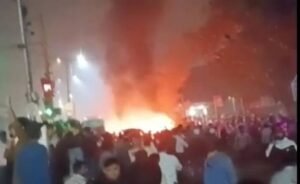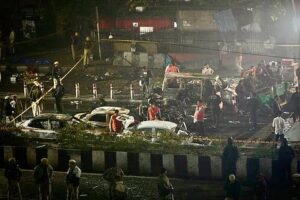Digital News Guru Delhi Desk:
A deadly car explosion on the evening of 10 November 2025 near the historic Red Fort in Delhi has been officially declared a terrorist incident by the Indian government. The blast killed at least eight people and injured several more, with early investigations pointing toward a premeditated attack rather than an accident.
Red Fort Area Explosion in Delhi
The explosion occurred at around 6:50–7:00 p.m. local time at a traffic signal near Gate No. 1 of the Red Fort metro station in Old Delhi, as a vehicle — identified as a white Hyundai i20 — stopped at a red light.

According to officials, the blast caused multiple nearby vehicles and auto-rickshaws to catch fire. Witnesses described a massive fireball, men and women running in panic, and scenes of devastation.
Early casualty reports put the death toll at eight with dozens injured; subsequent updates indicated as many as 10–12 fatalities.
Government Response & Investigation
Within days, the central government convened a meeting of the Cabinet Committee on Security and on 12 November passed a resolution officially labelling the blast a “terrorist incident” carried out by “anti-national forces”. In doing so, the authorities invoked broader powers under the Unlawful Activities (Prevention) Act (UAPA) and handed over the case to the federal counter-terrorism agency, the National Investigation Agency (NIA).
Prime Minister Narendra Modi vowed that the “conspirators” behind the attack would “not be spared”. Authorities announced compensation for victims’ families and directed state and central agencies to step up security across the capital and neighbouring regions.
Investigations have already flagged a possible terror cell with links to the Kashmir region, including arrests of suspects in Faridabad, and seizures of bomb-making materials. Forensic teams report that the explosive materials included ammonium nitrate, fuel oil and detonators — hallmarks of a sophisticated device rather than a simple vehicular accident.

Strategic and Symbolic Significance
The location of the blast — adjacent to the Red Fort, a 17th-century Mughal citadel that hosts India’s prime minister’s Independence Day address each year — adds a deeply symbolic dimension to the attack. The area is densely populated, part of the Old Delhi marketplace and tourist zone; an attack here carries both urban-target risk and psychological impact.
Moreover, the fact that this is one of the deadliest incidents in Delhi in recent years — reminiscent of past terrorism episodes — has heightened concerns over urban security in the national capital.
Why This Matters
- Security Paradigm Shift: The swift re‐classification of the incident as a terror attack signals a shift in the investigation’s trajectory — from possibly accidental to consciously planned. This allows use of tougher investigative powers, longer detentions and broader scrutiny of networks.
- Geopolitical Ramifications: With the Kashmir region under suspicion and India’s longstanding tensions with Pakistan still unresolved, this incident could have diplomatic implications — including cross-border probing, intelligence sharing and escalation of alert levels in adjacent states.
- Urban Vulnerability Highlighted: A blast in one of Delhi’s most crowded historic quarters underscores the vulnerability of major urban landmarks and tourist hubs — not just remote regions or porous borders.
- Public Confidence & Economic Impact: Tourism, daily commerce in Old Delhi, and the functioning of metros and transport hubs may see knock-on effects as security is ramped up; public anxiety could rise, with consequences for local economies.
- Counterterror Strategy in Focus: Questions around who supplied the explosives, how militants may have infiltrated the heart of Delhi, whether “white‐collar” terror modules (including professionals) are emerging — all will shape counterterror policies in coming months.
What to Watch Going Forward
- The probe’s first major deliverables: identity of the deceased driver (linked reports point to a doctor from Pulwama), motives, and whether it was a suicide or timed blast.

- Arrests and linkages: How far the investigation reaches into terror networks, including potential sponsors, logistics networks, and the trace of explosives from their source.
- Diplomatic response: Pakistan’s reaction, any pressure on Jammu & Kashmir region, cross‐border intelligence coordination or mutual accusations.
- Security measures implemented in Delhi, especially around iconic sites, transport hubs, and public gathering spots.
- Public / business response in Old Delhi: whether residents and market operations face disruption, how long recovery takes.
Conclusion
The car explosion near the Red Fort is a stark reminder that even centres of culture, commerce and history are not immune to violence and terror threats. The Indian government’s rapid response in re‐labelling it a terror act highlights the severity of the attack and the sensitivity of the site. As investigations continue, the outcome will matter not just for justice and closure for the victims’ families, but for the broader narrative of urban security, counterterror readiness and the symbolic resilience of India’s capital.
You May Also Read: Lucky Ali Opens Up on Three Marriages, Five Children and Life Beyond Bollywood








